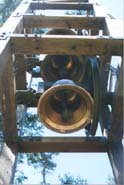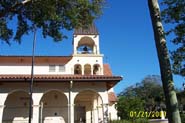

A peal of bells is generally a series of bells in a certain arrangement of musical tones, intended to be rung together. In North America, most peals are in free-swinging mountings; as bells of different sizes swing at different rates, when several such bells are rung together, the effect is one of an ever-changing pattern, a very live, joyous sound.
In America, most peals are of three bells; but peals of more bells can produce an especially magnificent effect, very appropriate for great festivals.
The musical note configuration of the bells of a peal will give different musical effects, and a number of traditional configurations have developed over many years. Some of these are named according to their possible derivations from traditional plainsong melodies.
Harmonic Peals
These will be peals in a configuration that produces a chord. The most popular
peal configuration over the past two centuries in North America has been
a major triad, as for instance, C--E--G. This is often termed an American
peal, for this reason; in some places, it is also called a Salve Regina peal,
after a well-known Mode V plainsong setting of that hymn; it is sometimes
extended to C--E--G--A--C, covering more notes found in the first line of
that tune, to form a five-bell peal.
Minor or European-Type Peals
These will be peals with a combination of a minor third and a major second, musically
speaking. The configuration C--D#--F is often termed a Te Deum peal, again
because of outlining the first three notes of a well-known Mode III plainsong
tune for this canticle. If the two intervals are inverted, giving for instance
C--D--F, quite a different, but very interesting, peal combination is produced,
that has been termed a Gloria peal, from the first three notes of the Gloria
from a familiar plainsong Mass of the Sixth Tone. Each of these may be extended;
the first is often extended to six bells, either C--D#--F--G--A#--C, or C--D#--F--G#--A#--C.
The Gloria peal has sometimes been extended to a five-bell peal, C--D--F--G--A,
which has been termed a Gloria-Te Deum peal, being really a combination of
the two forms.
Diatonic Peals
This sort of peal will follow the notes of a major scale, for instance, C--D--E.
Although there exist diatonic peals of five or six notes, free swinging, this
is somewhat rare.
All Souls Memorial Episcopal Church, Washington, DC Other Peals
The most famous peal combination apart from any of the above configurations is the Westminster peal, following the well-known quarter chime tune notes, but using them as free swinging bells. Again, for instance, starting from a C, this configuration would be C--F--G--A. It is quite a bit more common to use this arrangement of notes for time striking...see below.Clock or Quarter Chimes
Many different arrangements of bell notes have been used for the marking of the quarter hours for time striking over the centuries. The Westminster Chime has been by far the most used, since its introduction, apparently in Cambridge; it is thought that the tune was arranged by a Dr. Crotch after the Aria I know that my Redeemer liveth from Messiah by G. F. Handel. It acquired the name Westminster from its more famous use as the quarter chime in the tower connected with the house of the British parliament in that district of London (of which the hour strike bell is known as “Big Ben”).Certainly other sorts of quarter chime tunes are possible. The Westminster configuration allows an arrangement of the first line of the Lourdes Hymn (Immaculate Mary) to be used; we made a special quarter chime from that hymn to sound on our bells at Church of the Annunciation, Altamonte Springs, Florida, some years ago. The use of unique quarter chimes, specially arranged for a given location, is always possible, and we are happy to work with clients to develop them.



